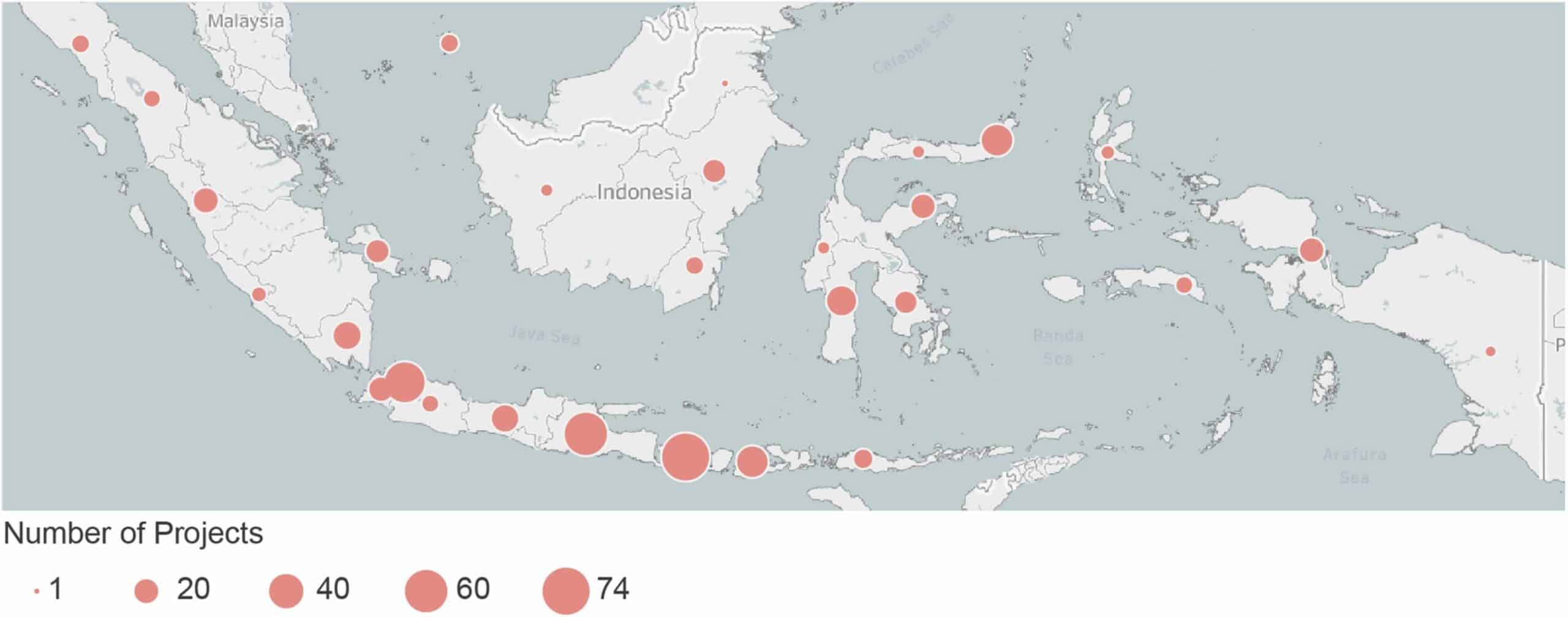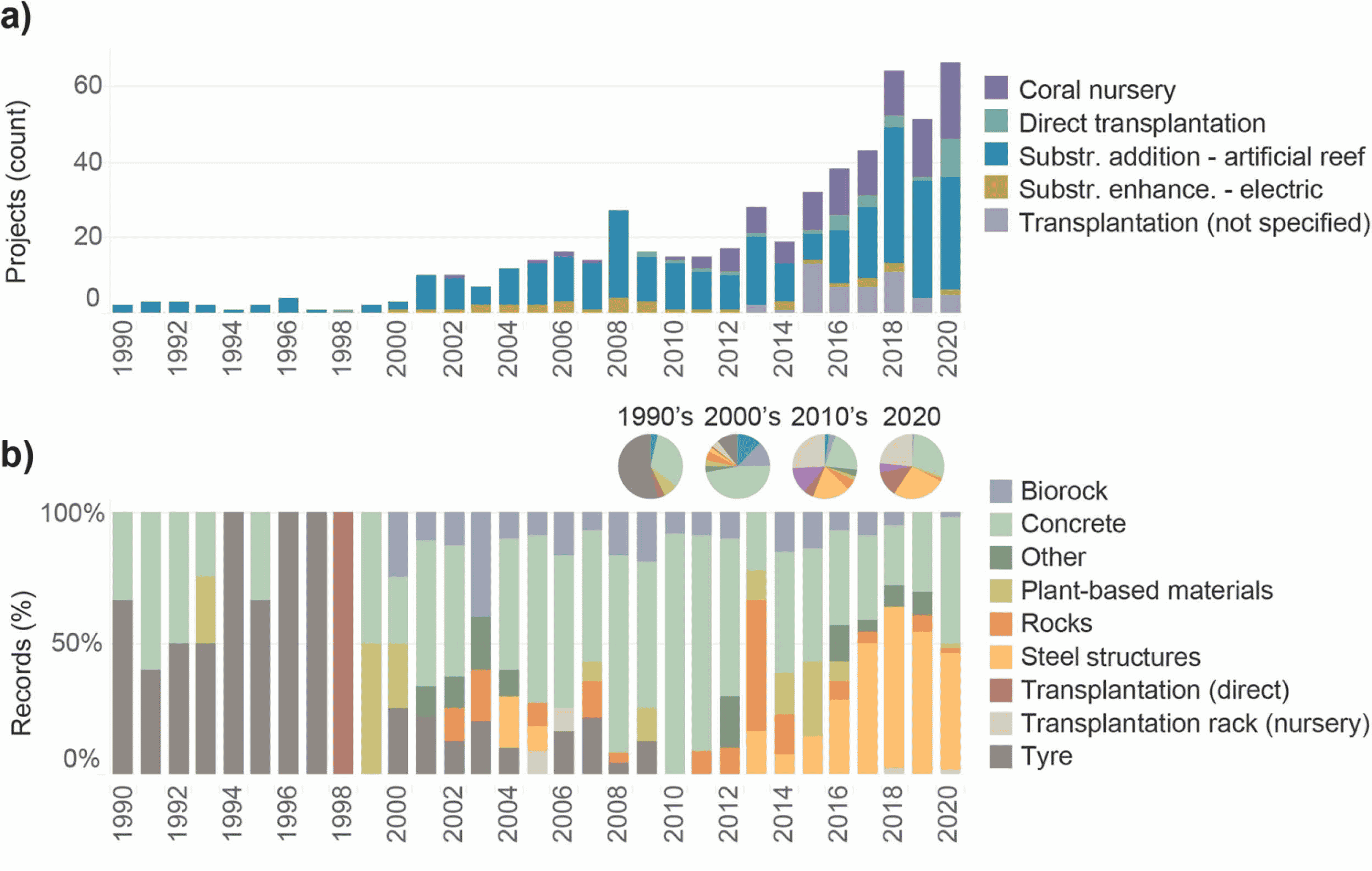What’s the overall scenario of coral restoration in Indonesia?
Written by Coralie Barrier
Acknowledgements to Dr. Tries B. Razak
Indonesia hosts 16% of the world’s total coral reef area, approximately 39,550 km2 [1, 2]. However, these ecosystems are affected by global and local degradation. In particular, dynamite fishing, although banned since 1985 [4], threatens the condition of 95% of the country’s coral reefs [2], as well as the lives of communities that depend on them. Nearly a quarter of Indonesians live within 30 km of a coral reef, making it the largest reef-dependent population in the world [3].
To counter coral reefs’ degradation, active coral reef restoration actions have been implemented for several decades in Indonesia [3]. The first documented artificial reef installation was carried out by the Indonesian Navy in 1979 [6, 3]. The aim was to rehabilitate a coral reef north of Jakarta by submerging materials such as tires that could be used as a stable substrate for coral colonization or as a habitat for certain fish [6]. With the number of projects increasing rapidly, by 2020 Indonesia was among the four countries with the most restoration projects [7].
Despite the popularity of restoration projects, until this year there was no database available to record them all [3], which has limited understanding of the overall scenario of reef restoration projects in Indonesia, their results and learnings, and their legal framework. In response to this void, researcher Dr. Tries B. Razak from IPB University and a team of international researchers recently published a review of Indonesian reef restoration projects and their legal framework in the scientific journal Marine Policy. The census highlighted the diversity of sources of project registration and provided the first publicly available database of Indonesian reef restoration projects, including reports, press and scientific research. In addition, this research has also highlighted the diversity of coral restoration stakeholders: governmental organizations, NGOs, private and community-based organizations [3].
What methods are used in Indonesian reef restoration projects?
The study identified 533 reef restoration projects implemented between 1990 and 2020. This covers 29 of the 34 provinces in Indonesia (Figure 1) representing, in total, approximately 120,483 artificial reef units [3].

Figure 1 : Coral reef restoration projects in Indonesia grouped by province from 1990 to 2020 (Figure and explanations modified from [3]).

Figure 2: Temporal trend of coral reef restoration projects in Indonesia. Temporal trends of restoration projects are illustrated by: a) restoration method; b) materials used (Figure and explanations modified from [3]).
Regarding the methods and materials used in Indonesian reef restoration projects, the results show that these are evolving and diversifying over time [3]. The first and most common restoration method referenced is the immersion of structures, namely artificial reefs (Figure 2a, in blue). For this purpose, the first structures to be used were tires and concrete (Figure 2b, in grey and light green) [3].
In the early 2000s, tires were gradually replaced by steel structures (Figure 2, light orange) [3]. Subsequently, many other structures appeared, such as: direct transplantation and biorock* [3]. This was at the same time as coral nurseries became popular (Figure 2a, purple) [3]. These changing developments show the diversity between each project depending on the availability of materials and affordability [3].
A lack of post-installation monitoring and external communication
However, the study also shows a need to implement project monitoring, as well as to standardize ecological monitoring methodologies. Only 16% of the 533 projects surveyed mention post-installation monitoring [3]. Indeed, many reports are not up to date or data on the fish community at restoration sites, the physical condition of the reefs or the survival/expansion rate of coral transplants are missing and therefore not usable [3].
Also, although Indonesia is recognized as the epicenter of coral reef diversity [2], much of the information related to their restoration activities is not accessible to the international scientific community, since publications are mostly in Bahasa and rather published in the Indonesian press. It is in this sense that the authors of the study highlight the efforts Indonesia has ahead of it in terms of communicating with the international community about their projects [3].
And what about Indonesian policies on coral restoration?
All these projects are governed by legislation, which was also examined by the authors. From this research, seventeen policies and regulations were identified as relevant to reef restoration in Indonesia. Several important points emerge from these national and regional policy documents [3]:
- Firstly, in Indonesia, it is necessary to have a regionally managed and administered permit, not necessarily a national one, for every proposed reef restoration or marine activity.
- Secondly, there are no strict regulations governing the methods and approaches to be adopted for reef restoration. Only the protection, enrichment and respect of ecosystems is amended by law.
- All policies encourage community participation in project planning and implementation, to share responsibility between government (central and local) and local communities.
Indonesian legislation therefore encourages regional management of projects and a diversity of stakeholders in reef restoration.
Conclusion
The need for action against the loss of coral ecosystems is urgent. Ecological restoration, one of the most widespread strategies, has seen rapid development since the 1980s in Indonesia, resulting in over 500 coral reef restoration projects. This has been made possible by a legal framework adopted by the Indonesian government, which is very engaged in safeguarding its marine biodiversity. For the first time in the scientific literature, the study of Razak and collaborators, presents a collection of coral reef restoration projects carried out on Indonesian territory as well as the evolution of the methods used and the legal frameworks.
In addition to demonstrating the diversity of the country, this collection of information has helped create the first database referencing all Indonesian reef restoration projects. This study also highlights the communication, knowledge and methodology sharing efforts that need to be made by Indonesia to optimize project management and achieve the desired objectives.
* Biorock: methods of mineral accretion of structures using a weak electric current through the anode-cathode effect.
References:
[1] World Bank, Oceans for Prosperity: Reforms for a Blue Economy in Indonesia. (2021).
[2] L. Burke, K. Reytar, M. Spalding, A. Perry, Reefs at risk revisited in the Coral Triangle, World Resources Institute, Washington DC., USA, 2012, pp. 1–72. 〈https://www.wri.org/research/reefs-risk-revisited-coral-triangle〉.
[3] T.B. Razak, L. Boström-Einarsson, C.A.G. Alisa, R.T. Vida, T.A.C. Lamont, Coral reef restoration in Indonesia: A review of policies and projects. Marine Policy, 137. (2022)
[4] R. Djohani, The combat of dynamite and cyanide fishing in Indonesia: A strategy to decrease the use of destructive fishing methods in and around Komodo National Park. The Nature Conservancy, Jakarta (1995) 1–47.
[5] R.G. Pearson, Recovery and recolonization of coral reefs, Mar. Ecol. Prog. Ser. 4 (1981) 105–122, https://doi.org/10.3354/meps004105.
[6] Sukarno, Terumbu karang buatan sebagai sarana untuk meningkatkan produktivitas perikanan di Perairan Jepara, J. Perair. Indones. Biol. Budidaya, Kualitas Lingkungan, Oseanografi. (1988) 87–91.
[7] Boström-Einarsson L, Babcock RC, Bayraktarov E, Ceccarelli D, Cook N, et al. Coral restoration – A systematic review of current methods, successes, failures and future directions. PLOS ONE (2020) 15(1): https://doi.org/10.1371/journal.pone.0226631

